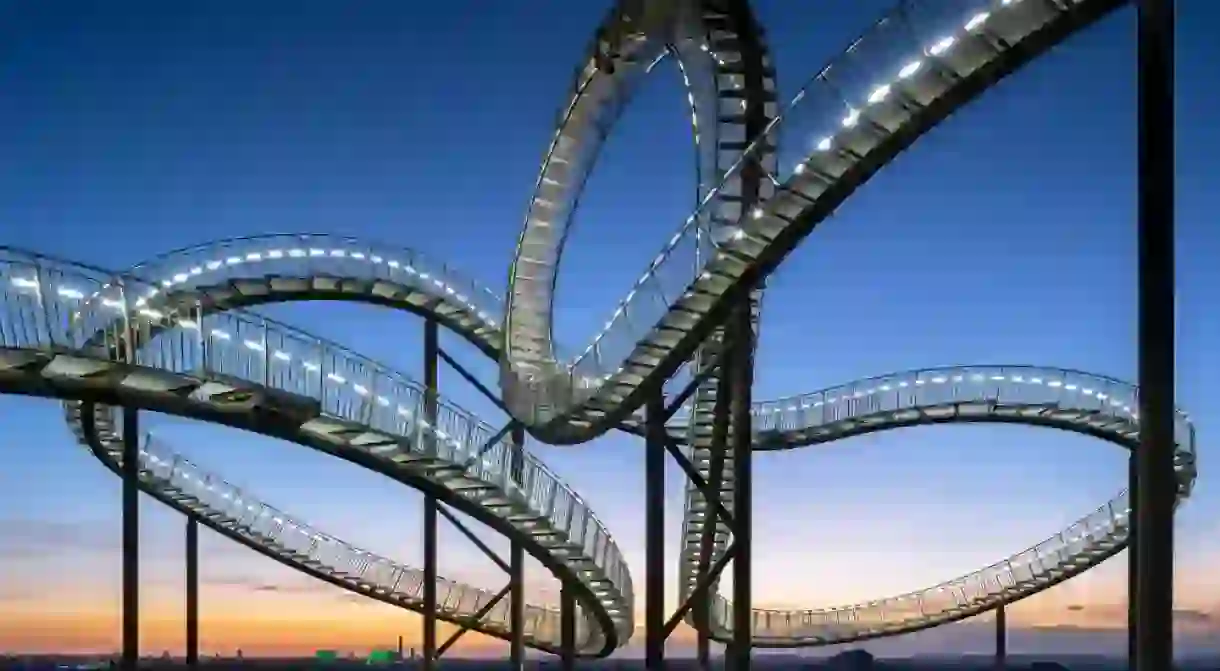The Top 10 Things to See and Do in Duisburg, Germany

The small city of Duisburg, very close to Düsseldorf, is worth a stop for its unique and diverse landscape composed of nature, industry, and contemporary architecture. This city, located at the junction of Rhine and Ruhr Rivers and boasting the world’s largest inland port, has a very rich industrial history. It is amazing how disused industrial infrastructure has been seamlessly blended with the modern developments of the city, providing a setting that is very hard to match.
Lehmbruck Museum
Museum

Lehmbruck Museum was constructed in honor of gifted artist Wilhelm Lehmbruck, famous son of Duisburg. The focal point of this museum is the collection of amazing sculptures by the likes of Alberto Giacometti, Alexander Archipenko, Picasso, Käthe Kollwitz, and Christo. You can also see priceless paintings from the 19th and 20th centuries by Nolder, August Macke, Max Pechstein, and Bauhaus artists.
Tiger & Turtle

Tiger & Turtle is a unique interactive art installation. It consists of winding, twisting staircases made of galvanized steel. It sits on a man-made hill, constructed out of waste from a former zinc-smelting factory and rubble from abandoned factories. Other than good exercise, the Tiger & Turtle provides visitors with lovely views of the industrial landscape and a sea of steep-sloped roofs.
Landschaftpark
Park

Landschaftpark is an abandoned steel facility that has been transformed into an awesome park. Instead of dismantling factory infrastructure like sewage canals, conveyor bridges, blast furnaces, bunkers, rail tracks, etc., they were re-purposed into walkways, gardens, a scuba diving center, and an observation deck. In the evenings, this park bathes in a sea of colorful, ever-changing lights. While you can enjoy the full illumination on Fridays, Saturdays, Sundays, and bank holidays, only the chimney stacks are lit on weekdays.
Museum Küppersmühle
Building, Museum

Museum Küppersmühle is a modern art museum that proudly displays precious artwork by gifted German artists, including Sigmar Polke, Abraham David Christian, Georg Baselitz, and Candida Höfer. Additionally, the museums hosts four temporary themed exhibitions every year. The building itself, seven stories tall and possessing 42-meter-high steel grain silos, is a sight in itself.
Duisburg Zoo
Zoo

The sprawling Duisburg Zoo is home to exotic birds, animals, and reptiles across almost 300 species. However, the biggest attraction of Duisburg Zoo is Germany’s largest dolphinarium, housing nine bottle-nosed dolphins capable of pulling off incredible tricks. Also, this zoo is one of the very few to breed fossas, a mammal native to Madagascar. You even get to see koalas here. What’s not to love?
Sechs-Seen-Platte

If you wish to take a break from Duisburg’s concrete, industrial landscape, you don’t need to go far at all. Sechs-Seen-Platte is a series of six interconnected lakes, which are so pretty that you would find it hard to believe that the area used to be a gravel pit. Sechs-Seen-Platte is the perfect place to walk, laze, play golf, or catch a meal in one of the restaurants.
Inner Harbor

During the Industrial Revolution, this region was lined with industrial buildings and factories. Also, grains used to be stored in gigantic granaries surrounding the inner harbor. After the war, this abandoned site was remodeled, and the old industrial heart was beautifully blended with contemporary buildings, parks, shops, restaurants, and hotels.
Museum der Deutschen Binnenschifffahrt
Museum der Deutschen Binnenschifffahrt, a museum dedicated to German inland navigation, is housed in a former public bath. In this museum, you can experience a walk-in replica of a vessel, a barge from the early 20th century, three ships docked at the harbor a short walk away, and the massive Oscar Huber (the last paddle steamer on the Rhine River).
Salvatorkirche
Church

Salvatorkirche towers over the heart of Duisburg, the Burgplatz. The church, built in the early 14th century, is a fantastic specimen of the late-Gothic style of architecture. Its truncated tower is a result of damage during the Second World War.
Kultur- und Stadthistorisches Museum
Museum
The Kultur- und Stadthistorisches Museum at the inner harbor is housed in a remodeled grain mill. The museum educates visitors about the history, culture, and folklore of Duisburg through exhibits and displays curated over 200 years. The main attraction of this museum is the collection of globes, maps, and atlases by famous cartographer Gerhard Mercator. You can also see coins and antiquities from the Köhler-Osbahr collection and a 16th-century Corputius plan, showing a precisely scaled, bird’s eye view of Duisburg.













